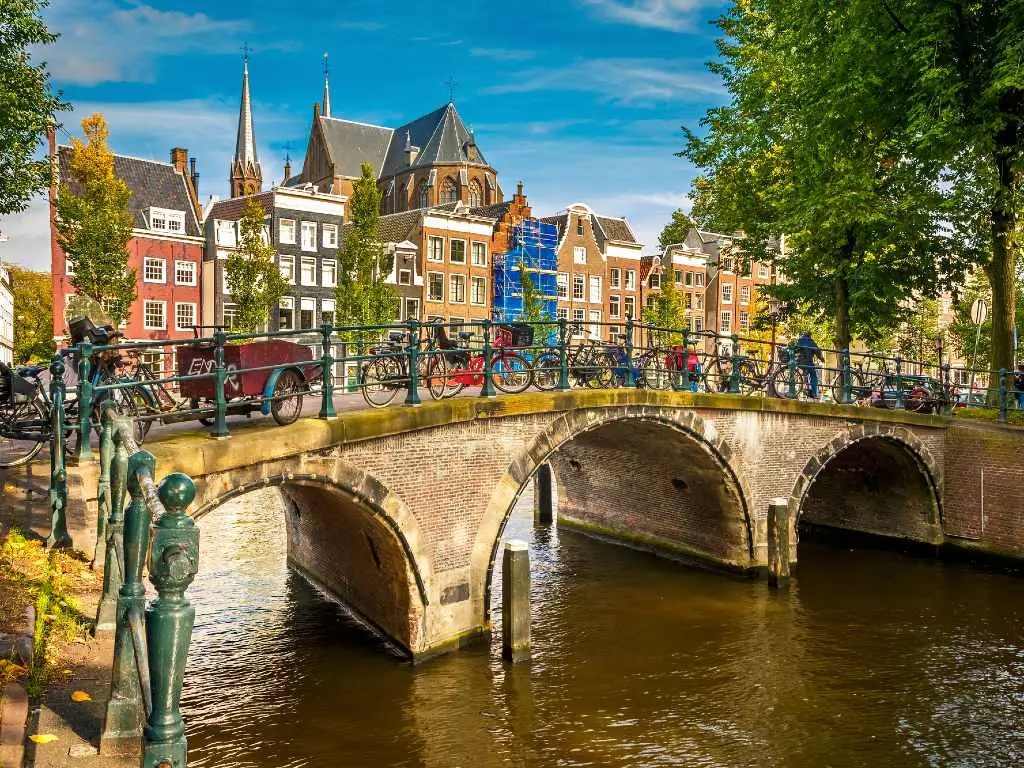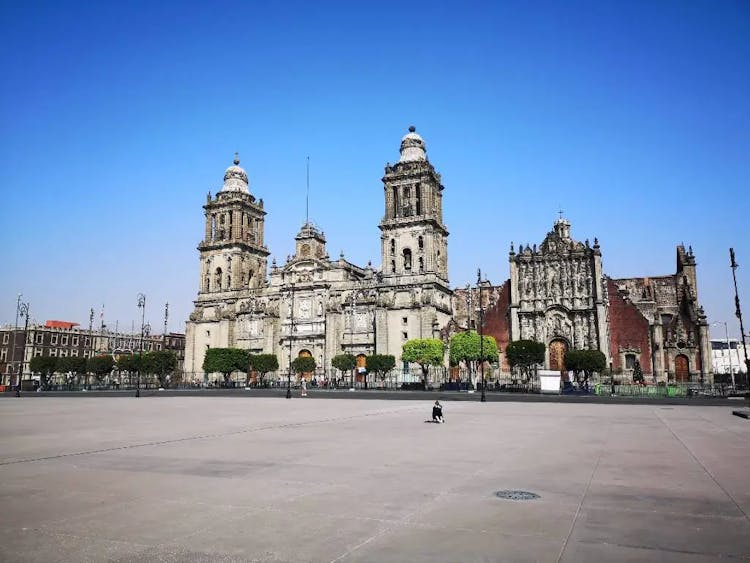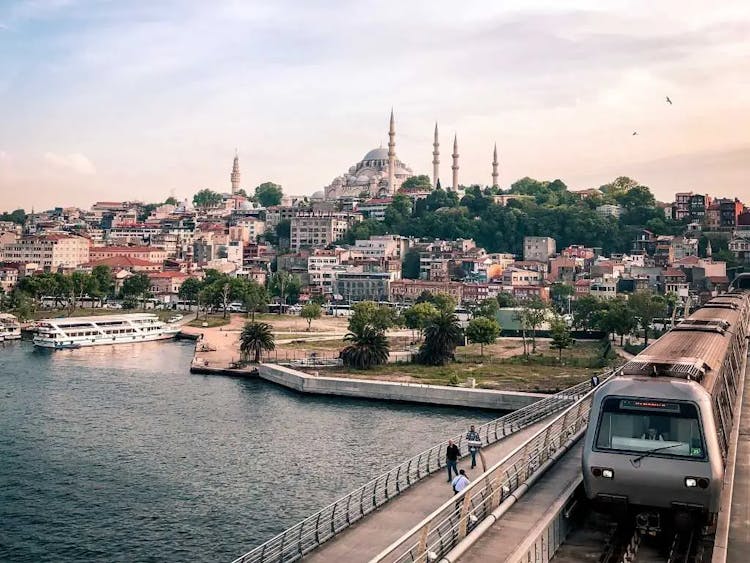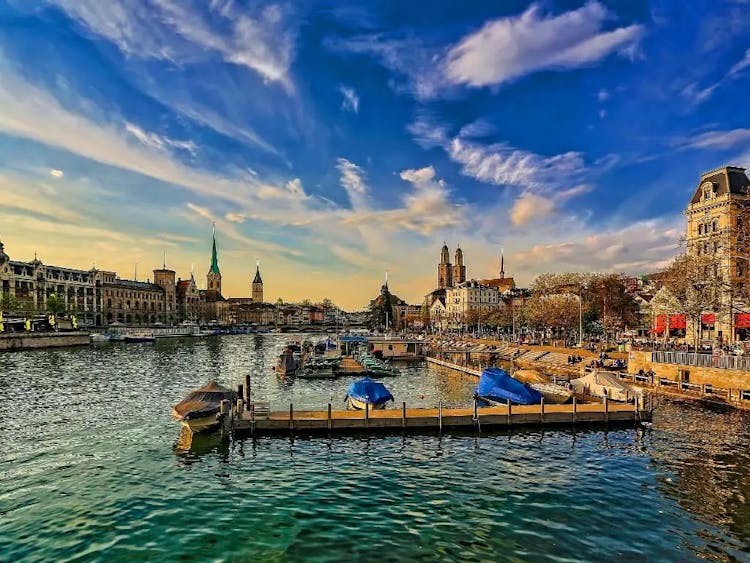
The Layover Guide to Amsterdam
Table of Contents
The capital of the Netherlands and its largest city, Amsterdam teems with beautifully preserved 17th-century Golden Age architecture, picturesque canals, and quaint cobblestone streets—all conveniently packed into just three square miles.
Thanks to the proximity of the airport to the city center, even a short layover allows you to take in many of Amsterdam’s highlights. Hop aboard a canal cruise or stroll through the intricate network of canals and bridges to see the city’s centuries-old gabled townhouses. Visit medieval-era churches and glorious monuments like the Royal Palace, or pop into one of its trio of world-class art museums to view masterpieces by Rembrandt, Van Gogh, and Mondrian. And be sure to relax with a Dutch beer and soak up some history in one of the city’s traditional brown cafes.

- VISA REQUIRED: No
- MINIMUM CONNECTION TIME, INTERNATIONAL TO INTERNATIONAL: 50 mins
- MINIMUM CONNECTION TIME TO LEAVE THE AIRPORT: 5 hrs
Visa info for the Netherlands
The Netherlands is part of the European Union’s Schengen Zone, which allows citizens of many countries, including the United States, to visit for up to 90 days without a visa.
Minimum layover times in Amsterdam
To make an international to international connection: 40-75 mins
Amsterdam Airport Schiphol (pronounced Shkip-hol), AMS, is a relatively compact airport, with a single terminal divided into three departure halls, numbered 1, 2, and 3, with gates designated by letters (B, C, D, E, F, G, H and M).
The airport is separated into Schengen and non-Schengen zones, with most international flights arriving in Hall 2, the largest hall. (A new gate on the south side of the airport was set to debut in 2021, with eight additional gates, however, construction has been delayed due to Covid.)
The single-terminal design allows passengers to walk between gates, which means there are no internal trains, buses, or other means of transiting between areas (though there are moving walkways). Depending on your arrival gate, it can take anywhere from a few minutes to around 20 minutes to walk to your connecting flight gate, plus additional time to get through passport control and security checks if traveling internationally.
KLM Royal Dutch Airlines, Schiphol’s largest carrier, recommends a minimum connection time of 40 minutes for flights within Europe and 50 minutes for an international flight.
To avoid having to sprint through the airport or worry about missing your flight in case of delays, a better option is to choose itineraries with a layover of at least 60 to 75 minutes, especially if you are changing from one carrier to another outside of the same air alliance. (For example, most low-cost carriers such as EasyJet are stationed in the farthest terminal, Gates H and M.)
For layovers, it’s best to have your luggage checked through to your next destination. Allow additional time if you need to collect, store, and re-check bags. Schiphol has a Baggage Storage area as well as secure lockers that fit standard hand luggage; fees range from €6–€12.
To leave the Amsterdam airport and explore for part of the day: 5 hrs
Thanks to excellent train connections between the airport and the city, you can quickly and easily get to the heart of Amsterdam and be within walking distance of many major sites.
Be sure your layover is at least five hours to give yourself time to explore and find your way back to the main train station (Amsterdam Centraal); the city is compact, but it’s also easy to get lost in the maze of narrow, winding streets and canals. Take into account transportation time back to the airport, clearing airport security, collecting any stored bags, and being at your gate at least 30 minutes before departure for Schengen flights or 45 minutes for international flights—plus any delays.
A 5-hour layover means a little more than 2 hours to explore; a layover of 7-8 hours gives you more time to enjoy the city without rushing.
- 30-45 minutes to deplane and go through immigration and customs
- 15 mins to transit to downtown by train
- 2.5 hours to explore
- 15 minutes to return to airport
- 1.5 hours to go back through security, get to your gate, and board the plane
Getting from the Amsterdam Schiphol airport to the city center
- BUS: 30 mins
- TAXI: 25 mins
- TRAIN: 15 mins
The fastest and cheapest way to the city center from the airport is by train, which takes approximately 15 minutes. Taxis take longer and cost significantly more. Uber is slightly less expensive than a taxi, but you’ll have to locate the pickup point (depending on whether you choose UberX or UberBlack), which can be confusing.
The airport train station is located one level below the main terminal building (Schiphol Plaza) and is clearly marked. Intercity trains, operated by NS (Netherlands Railways), run directly from Schiphol Airport to Amsterdam Centraal Station (Amsterdam CS), and usually depart from platforms 1 or 2. Purchase your ticket using a credit card or euro coins from one of the automated ticket vending machines or from a ticket window (bills are also accepted) before heading down to the platform. The cost for a one-way ticket is €5.60, which includes a €1 surcharge for a disposable ticket. The train runs 24 hours a day, every 10–15 minutes between 6am and 1am, and every hour for night service.
The Amsterdam Airport Express (bus 397) is located right outside of Schiphol Plaza. The cost of a ticket is the same as the train and can be purchased at an automated ticket vending machine located at the stop. If you are going to the Rijksmuseum or the Van Gogh Museum, the bus is the fastest way, as there are stops close to both museums.
How to spend a short layover at the Amsterdam airport
Schiphol Airport is home to a myriad shops, restaurants, and bars and there’s even an outpost of the Rijksmuseum with a rotating selection of original artwork from its world-class collection.
Schiphol Plaza, the shopping center before security, is great for picking up less-expensive items and snacks from local stores, including the supermarket chain Albert Heijn, Etos drugstore, and HEMA (the Dutch version of Target). There are also Dutch clothing boutiques including Hunkemöller (for lingerie) and G Star (for denim) and several stores where you can pick up bulbs, tulip-themed souvenirs, and Dutch cheese.
Once past security, there’s the typical array of high-end fashion and accessories from international brands such as Burberry, Bulgari, Hugo Boss, and Montblanc. You’ll also find GASSAN, Amsterdam’s famous diamond maker, which has been cutting gems for more than four centuries.
Food choices run the gamut—from fast food to pub grub to sushi—plus classic Dutch specialties like bitterballen (deep-fried croquettes filled with meat gravy) and of course, Amsterdam’s iconic Heineken beer. For something different, De Verspillingsfabriek (The Waste Factory) uses surplus vegetables—rejected because of their shape or size—to make fresh, healthy soups.
There’s free WiFi throughout the airport, and various lounges that are accessible to any traveler for a fee.
Plane-spotters can watch planes taxiing, taking off, and landing from the Panorama Terrace on the roof of Departure Hall 1 (before security). There is also a real KLM Fokker 100 airplane on display that you can tour. Admission and use of the stationary binoculars are free. (Note: the terrace is undergoing renovations; check the Schiphol website here for updates.)
How to spend a short Amsterdam layover outside the airport
If you have four to six hours, take the train below the main airport terminal and in about 15 minutes you’ll arrive at Centraal Station in the city center. From the pier just outside the station, hop on any of the one-hour canal cruises that wind through the city—it’s one of the best ways to get a feel for Amsterdam. Lovers Canal Cruises and Stromma both have frequent departures year-round.
A short stroll down the wide Damrak avenue brings you to the 13th-century Dam Square (known as “The Dam”), a sprawling cobblestone plaza framed by several important attractions. Most impressive is the massive neoclassical Koninklijk Palace, the official residence of the Dutch royal family since the 17th century, whose public rooms are open to the public to tour. The neighboring Nieuwe Kerk (New Church), dating from the 15th century, now functions primarily as an arts venue; it’s worth a stop to see its intricate stained-glass windows, the ornately carved altar and towering brass choir screen, and the largest pipe organ in the Netherlands.
From there, cross over the Singel canal and head into the UNESCO World Heritage-listed Canal Ring, which best captures the magnificent beauty and wealth of Amsterdam’s Golden Age. Lining its three grand canals—the Herengracht, Keizersgracht, and Prinsengracht—are the city’s trademark gabled townhouses, most of which date from the 17th century. Two canal-side mansions have been turned into house museums, giving you a glimpse into how the aristocracy lived. The Museum Van Loon and the Willet-Holthuysen Museum both feature beautifully restored interiors complete with period furnishings and artwork.
Allow yourself time to wander among the Canal Ring’s maze of picturesque cobblestone lanes, crisscrossing its many bridges and soaking up the Golden Age atmosphere. Landmarks in the area include Westerkerk, a 17th-century church and the burial place of Rembrandt, the Anne Frank House (tickets need to be booked online two months in advance), and the Homomonument, a triangle-shaped memorial commemorating persecuted gay men and lesbians.
How to spend an overnight layover in Amsterdam

Take advantage of an overnight trip or a long layover in Amsterdam to see the city's incredible art treasures: the Rijksmuseum for its unparalleled collection of Dutch Old Masters, the Stedelijk for modern and contemporary art and design, and the Van Gogh Museum, with more than 200 paintings by the tortured Dutch artist. This trio of art institutions all flank the vast Museumplein park in the city’s Museum Quarter. Keep in mind that the Van Gogh Museum requires advance timed tickets, which can only be purchased online; you may also want to reserve online tickets for the Rijksmuseum, as ticket lines can be long.
If you have time, check out one of the city’s newest additions, Moco, also on Museumplein; the small museum specializes in street art, with several pieces by graffiti star Banksy, as well as Pop Art from the likes of Warhol.
Evenings, get cozy in one of Amsterdam’s authentic, old-school watering holes known as brown cafés (or brown bars). The best brown cafés are like time capsules—dimly-lit, wood-lined, and brimming with historical touches. Sip a local beer or try a shot of jenever (Dutch gin) while munching on hearty Dutch snacks like bitterballen. Many brown cafes can be found in the city’s infamous Red Light District, including In’t Aepjen, one of Amsterdam’s oldest bars, founded in 1519. Bursting with monkey-themed paraphernalia (the bar’s name translates to “In the Monkeys”), the small, quirky space fills up quickly with a mix of locals and tourists, so be sure to claim your spot early.
Speaking of the Red Light District, while you might be tempted to roam its atmospheric streets, try to avoid doing so late at night. It’s more seedy than dangerous, but it does attract hordes of young male tourists—many of them drunk, stoned, or both—who come to ogle the scantily-clad sex workers posing in the illuminated windows. This district is also where you’ll find the highest concentration of “coffee shops,” where pot is legally sold and smoked.
For a short stay in Amsterdam, you’ll want to book a hotel in the city center to maximize your time. However, be aware that hotel rates are quite high, on par with major European cities like Paris and London, and especially so in summer.
The Old Center, the Canal Ring, and the Museum Quarter are the most desirable areas (with hotel prices to match). More affordable districts that are still centrally located include De Pijp, to the south, and Amsterdam Noord, which can easily be reached via a 24-hour free ferry behind Amsterdam Centraal. Keep in mind that many of the smaller hotels and quaint B&Bs don’t have elevators and there can be very steep stairs to get to your room.
Need to Know
- CURRENCY: Euro
- LANGUAGE: Dutch
- SAFETY: A
- COST: $$$$ (out of $$$$$)
- BEST TIME TO GO: May–October
Currency in the Netherlands
The official currency is the euro. Debit cards are the most widely used form of payment in the Netherlands; many smaller boutiques, restaurants, and bars will only accept PIN-only debit cards supported by Maestro, which means your American debit card may not work. If you see the “PIN-only” sign in the window, be sure to ask if the establishment will take cash. Major attractions, larger stores, and tourist-friendly restaurants all take major credit cards.
Cost in Amsterdam
Even though Amsterdam has a reputation for attracting youthful, party-hardy crowds, it’s a surprisingly expensive city.
A mid-range hotel averages around $175 a night, and prices can soar in the summer months. A mid-range dinner costs between $25 and $50 per person, without drinks, depending on the number of courses. Beer and wine are relatively affordable, averaging around $5 to $8 for a pint or glass, but alcohol is highly taxed, so even the most basic cocktail (like a gin and tonic) will set you back at least $12.
Weather & Best Time to Go to Amsterdam
Mid-April through September generally offer the best combination of daylight and warm temps—and far less chance of rain. In spring, the iconic Dutch tulips start blooming, usually starting in March and lasting through mid-May. Summer is by far the best time to visit, with a slew of festivals that take advantage of the long, sunny days when temps average in the high-70s Fahrenheit. Of course, it also coincides with peak tourist season, so be prepared for the trade-off.
Early autumn can be quite pleasant, with crisp fall days and fewer crowds. If you visit in late fall or winter, be prepared for rainy, blustery conditions, short days with little sun, and temps in the mid-40s. It rarely gets cold enough to snow in Amsterdam, but the dampness and wind makes things feel chillier. Despite the inclement weather, the holiday season is a festive one, kicking off with the Amsterdam Light Festival in early December, when Amsterdam and its canals are illuminated with contemporary light installations.
Safety in Amsterdam
The Netherlands is one of the world’s safest countries, ranking 17th on the Global Peace Index (2019). However, Amsterdam, like most major cities, has a fair share of pickpockets, especially in popular tourist areas like the Red Light District and on crowded trams. While police have been cracking down on the rowdy groups of young, drunk tourists that plague the Red Light District, you should exercise caution and avoid the area late at night.
Transport in Amsterdam
Amsterdam is a compact, extremely walkable city, but you’ll no doubt be tempted to take part in the Dutch bike culture. Do keep in mind that for locals, biking is the primary method of transportation—not a casual way to see the city. If you’re going to hop on two wheels, make sure you know the rules of the road, including how to properly signal when turning, and use extreme caution in congested tourist areas and when riding over tram rails.
Bike rentals can be found all over the city; Rent a Bike is conveniently located near Dam Square with bike rentals starting at €6.25 for three hours.
The city’s highly efficient public transport system, GVB Amsterdam, features an integrated network of trams, buses, and the Metro—and is entirely cash-free. You can buy single-use tickets (3.20 euro), which are valid for one hour, as well as one-day and multi-day transit cards, which start at 8 euro for 24 hours, at the automated ticket vending machines. For trams and buses, be sure to buy a ticket beforehand (some busier tram stops have automated ticket vending machines), as the onboard machines generally won’t work with US debit or credit cards. With transit cards, remember to hold your ticket to the electronic reader onboard both when you get on and off your ride.
Ferries, most of which leave from behind Centraal Station traveling across the IJ Harbor to Amsterdam Noord, are free.

Food & Drink in Amsterdam
While Amsterdam has seen a growing number of Michelin-starred restaurants (there are currently 18 one- and two-star establishments) and an influx of global cuisine, typical Dutch fare isn’t particularly exciting. Nearly every bar and restaurant menu offers snacks of bitterballen, fried croquettes stuffed with gravy and meat, and plates of Gouda cheese. Popular at lunch are broodjes (pronounced “bro-ches”), basic sandwiches stuffed with meat, cheese, shrimp, or fish. Ubiquitous haring stands sell raw herring that’s been pickled in vinegar—definitely an acquired taste. The Dutch also love fries and there are stands all over the city; they’re usually served in a paper cone and topped with mayonnaise and curried ketchup.
One experience not to miss is rijsttafel, which translates to “rice table,” an elaborate banquet of traditional Indonesian specialties adapted by the Dutch (who colonized Indonesia in the 16th century). Come hungry, as plate upon plate of sweet and spicy dishes—satay, tamarind beef, fried coconut—arrive on your table, served with sticky white rice so you can blend the various flavors. Long Pura in the Jordaan area and Restaurant Blauw in Old Zuid are two great spots to sample this feast.
For sweets, there’s the famous Dutch stroopwafel, two round wafer-thin waffles with a layer of caramel syrup in between. You can find these chewy treats prepackaged all over the city, but the best are made fresh and eaten warm; there are several stroopwafel stands at the Albert Cuyp Markt, Amsterdam’s biggest street market, located in De Pijp.
Language
The local language is Dutch but nearly everyone speaks English—and speaks it extremely well. In tourist areas, most signs and menus are also in English.
Don’t miss
It’s practically a rite of passage to ride on one of the signature clanging blue-and-white trams that wind through the city streets. There are 14 routes, most of which begin and end at Centraal Station. Line 2, named by National Geographic Traveler as one of the world’s best tram rides, rolls by many of Amsterdam’s major sites, including the Royal Palace, the Canal Ring, the Rijksmuseum, Museumplein, and Vondelpark. The journey can be achingly slow, so don’t take one if you’re in a hurry.
Don’t bother
Don’t expect to see real tulips, or fresh flowers of any kind, at Bloemenmarkt, a floating market anchored along the Singel canal. The last florist closed in 2019; today, most stalls are stuffed with kitschy trinkets (think: wooden tulips and clog-shaped magnets), though you can still purchase tulip bulbs and gardening paraphernalia.
See Going's deals on flights to Amsterdam, and join today to get cheap flights from all over the world delivered right to your inbox.
Published November 30, 2023
Last updated December 21, 2023
Treat your travel to cheap flights
Most deals are 40-90% off normal prices with great itineraries from the best airlines. If it's not an amazing deal, we won't send it. Sign up for free to start getting flight alerts.




